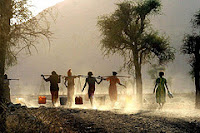This image show a vegetation landscape in Rwanda that has been affect by the climate changes. Because of the sun, the land became more arid and hard. The lack of trees leads to the soil degradation.
In Rwanda, most of the population survive from fresh food straight from farms. Therefore, vegetation is more needed there in order for people to survive. In class we studied some forest where the land is covered by big trees that protect the ground from the sun. Climate changes has affected the vegetations sources. Things like water is a necessary element for plants and in some region, water has been rare. There also most plants that survive by water The more trees covers the land or vegetation, there is a shadow that protect the land from the sun. In class we went over the example of some plants that keeps water, some that don' need water to survive and those that need both water and the sun.
 |
| This is a plantation of tea. When the climate is favorable, people can even use the mountain for more foods. |
 |
| This is an example of a fertile and green land. Some of the elements that make the land more fertile are animals like Cows, goats. I am not sure about the name in English may be it is called "mulch". |








